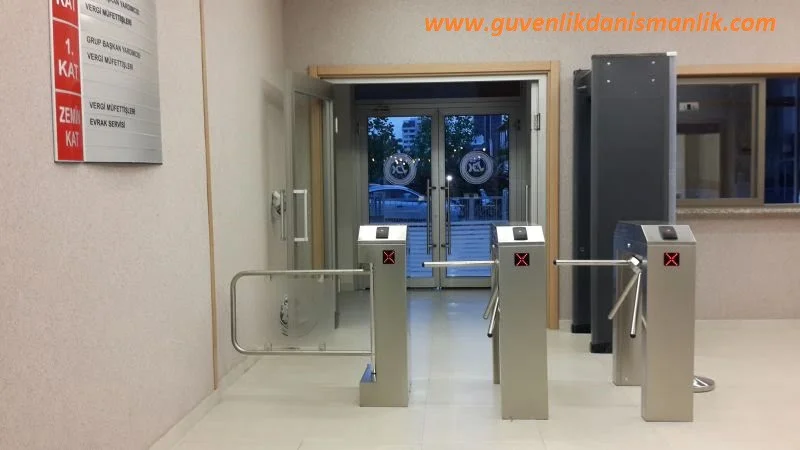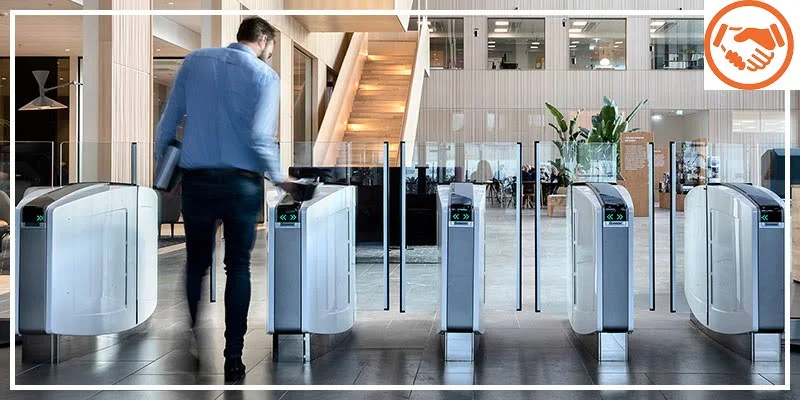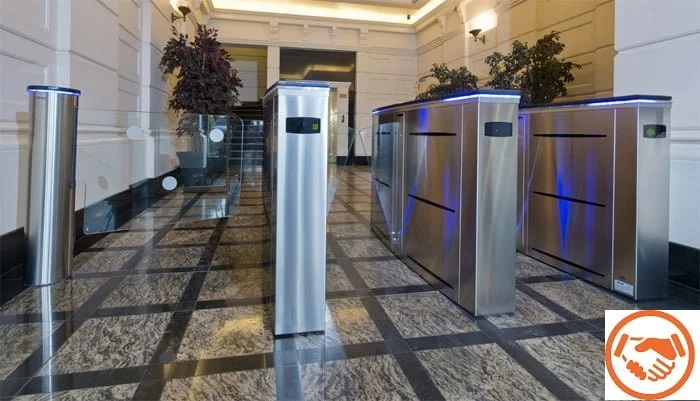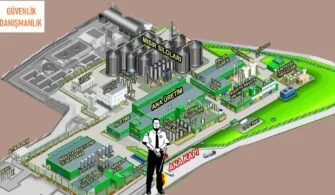What is a Turnstile System?
A passage turnstile system is an automatic passage system that allows safe control of entry and exit in many different areas. This system can be used in various fields such as offices, schools, stadiums, metro stations, airports, etc.
Passage turnstiles can work together with different identity verification methods such as card readers or biometric readers used to verify people’s identities. It allows people with authorized access to pass through while preventing those who do not have permission. This provides security and access control.
Passage turnstiles can operate mechanically or electronically. Mechanical turnstiles are typically equipped with three arms and offer the option of bi-directional or unidirectional entry/exit. Electronic turnstiles are controlled by electronic mechanisms and work together with identity verification devices such as card readers or biometric readers. Additionally, emergency passage buttons or alarm systems are available to open the turnstile in case of emergency.
How does a turnstile system work?
The turnstile system is designed as a security system used to control entry and exit in places with high human traffic. Its working principle is carried out through an electronic system where a barrier, usually an arm or barrier, is controlled by a mechanism that allows it to open.
This system generally uses biometric recognition technologies such as card readers, fingerprint readers, or facial recognition technology to authenticate users’ identities. After the user’s identity is verified, a motorized mechanism located inside the turnstile opens the barrier and allows the user to pass.
In addition, the turnstile system offers many different control options such as direction control, passage count, and access levels. Thus, these systems allow users with different access levels to only enter designated areas.
What are the types of turnstile systems?
Turnstile systems are available in several different types with different features and functions. Some of these include:
- Tripod Turnstiles: Tripod turnstiles are a turnstile system with a triangular barrier, suitable for use in smaller capacity areas.
- Full-Height Turnstiles: Full-height turnstiles are full-sized turnstile systems with a gate-like barrier. This type of turnstile is commonly used in areas where high security is required.
- Speed Gates: Speed gates are designed for high-volume traffic. This type of turnstile has a high-speed opening and closing mechanism, allowing users to pass quickly and smoothly.
- Glass Turnstiles: Glass turnstiles are turnstile systems with modern and stylish designs featuring glass barriers. These turnstiles are used particularly in prestigious areas such as luxury buildings and shopping centers.
- Security Turnstiles: Security turnstiles are turnstile systems equipped with identity verification technologies, metal detectors, and other security features. This type of turnstile is used in areas where high security is required, such as airports, banks, and public buildings.
Some points to consider when choosing a turnstile are:
- Security: The security features of the turnstile, such as access control and prevention of unauthorized entries, should be taken into consideration.
- Capacity: The capacity of the turnstile, i.e. the number of people that can pass through per hour, should be determined according to the traffic of the area where it will be installed.
- Installation: Factors such as the characteristics of the area where the turnstile will be installed, the installation surface, the dimensions of the installation area, the strength of the walls and ceiling, power supply, and cable connections play an important role in the selection of the turnstile.
- Aesthetics: Choosing a turnstile that matches the decoration of the area where it will be installed is also important from an aesthetic point of view.
- Maintenance and Repair: Easy maintenance and repair of the turnstile, and the ability to quickly address malfunctions are also important. Therefore, before purchasing the turnstile, issues such as service support and warranty period should also be reviewed.
- Technology: The technology used in the turnstile is also an important factor when selecting. Especially in automatic passage systems, choosing the latest technology products provides higher security and functionality.
- Maintenance and support: Maintenance and support services of the selected turnstile should also be taken into consideration. Choosing a reliable brand makes it easier to receive technical support when needed.
- Cost: Finally, cost is also an important factor in turnstile selection. Choosing a turnstile that is budget-friendly and meets the requirements will reduce costs in the long run.
Turnstile system, how is the passage capacity calculation done?
To calculate the passage capacity of a turnstile system, the following factors need to be taken into account:
- Average Daily Traffic: The average daily traffic in the area where the turnstile system will be installed should be determined. Based on this, the capacity of the turnstile system can be determined.
- Peak Traffic Time: The peak traffic density, especially during rush hours, should be taken into account in the area where the turnstile system will be installed. The capacity of the system should be sufficient during peak traffic times.
- Traffic Direction: The direction in which traffic density is higher in the area where the turnstile system will be installed should be determined. Accordingly, the capacity of the turnstile system should be determined.
- Type of Traffic: The type of traffic that will take place in the area where the turnstile system will be installed should also be taken into account. For example, a turnstile system that allows only one-way traffic will be insufficient in an area where two-way traffic will take place.
- Passage Time: The average time it takes for users to pass through the turnstile system should also be taken into account. Accordingly, user passage times should be considered when determining the capacity of the turnstile system.
- Usage Area: The characteristics of the area where the turnstile system will be installed also affect capacity calculation. For example, a turnstile system designed for a narrow area will be insufficient in a wide area. The width of the usage area should be taken into account when determining the capacity of the turnstile system.
What is the average turnstile passage time?
The average turnstile passing time may vary depending on factors such as the type of turnstile, the number of people passing through, the speed settings of the turnstile, and other factors. However, generally, the turnstile passing time can range from a few seconds to 10 seconds. For example, a tripod turnstile typically has a passing time of 2-3 seconds, while a fast-pass radio-frequency turnstile can have a passing time of 1-2 seconds.
What is a Fast Passage Turnstile?
Fast passage turnstile is a type of turnstile known for its high passage capacity and fast passage feature. These turnstiles are designed for use in places with high passage traffic, such as special passages requiring fast passage in emergency exits or with card access systems.
Fast passage turnstiles usually use a mechanism operated by an electric motor to open and close, allowing for very fast passage. Additionally, due to the wide opening of the turnstile, it is possible for disabled or wheelchair-bound individuals to easily pass through.
Fast passage turnstiles are made of high-quality materials and typically use durable materials such as stainless steel or aluminum. Moreover, many fast passage turnstiles come with an integrated card access system, making it even easier to control entry and exit.

Turnstiles are used in many different areas where entry-exit control is needed. Some of these areas are:
- Office buildings: Office buildings, plazas, banks, and other business centers are usually equipped with turnstile systems. This ensures that only authorized persons can enter the building.
- Airports: Turnstile systems are often used at airports for the safety of passengers. This allows only passengers who are preparing to fly to enter the area.
- Metro stations: Turnstiles are used in metro stations with heavy traffic to control entry and exit, and to allow only ticketed passengers to pass.
- Stadiums: Turnstiles are used in stadiums to control the entry and exit of fans, ensuring that only ticket holders enter the stadium.
- Entertainment centers: Turnstiles are also used in malls, cinemas, and other entertainment centers to ensure that only authorized individuals enter the area and prevent theft and other incidents.
- Public transportation systems: Turnstiles are used in public transportation systems such as bus stops and train stations to ensure that only ticketed passengers pass through.
There are many brands in the field of turnstile systems. Some of the prominent brands among them are:
- Ozak Turnstiles
- Alpro Turnstiles
- Gunnebo Turnstiles
- Tansa Turnstiles
- Delta Turnstiles
- ZKTeco Turnstiles
- Came Turnstiles
- Ozsefa Turnstiles
- Hormann Turnstiles
- Safegate Turnstiles
In addition to these brands, many different manufacturers and suppliers also offer turnstile systems. The choice of which brand to use may vary depending on needs and budget.







